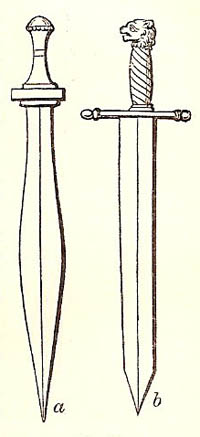sword

Greek and Roman swords.
A sword is a weapon of offence consisting of a blade fitted into a hilt or handle, with a guard, the blade being formed to cut or pierce, generally to do both. In different places and times, the sword has taken many forms from short cutting and piercing daggers and poignards to the heavy two-handed swords of the 15th century, the blade varying in length from a few inches to four feet or more. It may furnished with a cutting edge on one side only, or on both sides. It may be uniform in breadth throughout with a truncated end, or it may taper from the hilt to a fine point. The blade, moreover, may have a piercing point alone, as in the rapier, and it may be curved throughout its length, as in the oriental scimitar. The hilt, with its many forms of guard, grip, and pommel, adds further possibilities to variations in the weapon.
The sword came into use only when man had acquired skill in casting and working bronze, and the ancient bronze swords, many of which have been found throughout Europe with two-edged blades measuring two feet in length, are well finished weapons. The early Greek sword (a) was merely a strong two-edged knife; but about 400 BC its form was improved and its size doubled by Iphierates. The Roman gladius (b) (see Roman army) was still of the same form – a straight two-edged blade, heavier and longer, however, than the Greek weapon.
During the early middle ages there doesn't appear to have been much development in the form of the sword in Europe. As shown by the Bayeux tapestry and other contemporary illustrations, it continued to be a short cutting weapon, with a blade of uniform breadth bluntly pointed, and to give it balance it was channeled from the hilt for about two thirds of its length. The cross-guard, subsequently called the quillons, was short, projecting at right angles from the blade, but sometimes bent forward in the direction of the point.
With the development of armor in warfare it became necessary to give much greater weight and strength to the sword; the blade was generally lengthened and tapered from hilt to point, the guard and the hilt were also lengthened, and in this way the two-handed sword – the distinguishing arm of the 15th century – was evolved. In Scotland several of these ponderous weapons are preserved, and traditionally associated with the names of Wallace, Bruce, and other contemporary heroes; but such weapons were really not in use in so early a period. With the introduction of the two-handed sword, the use of a shield no longer being possible, the guard gradually became more complicated, so as to give greater protection to the hands of the swordsman, and from the use of shell-guards and ring-guards, etc., the basket-hilt, as applied to lighter swords, was gradually developed. The ordinary basket-hilt sword is of Italian origin and grew out of the Venetian schiavone. The rapier – a piercing weapon only, with a blade tapering to a fine point – came into use in the early part of the 16th century, and in the seventeenth century it became the weapon of fencing and dueling.
From very early times Toledo and Seville, and some other Spnish towns had a high reputation for the excellence of the swords made by their armorers, and when to their own skill was added the craftsmanship of their Moorish conquerors the renown of Spanish blades became supreme. In the North Italian towns also, as well as at Solingen and Passan in Germany, swords of famous quality were fabricated.
 |
| Scottish two-handed sword
|
